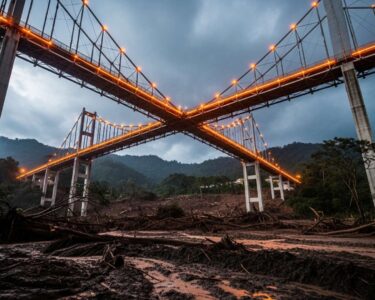Alajuela, Costa Rica — MUELLE DE SAN CARLOS, Alajuela – A critical infrastructure project in Costa Rica’s Northern Zone is rapidly approaching completion, promising to alleviate a long-standing traffic hazard and improve regional connectivity. The Ministry of Public Works and Transport (MOPT) announced this week that the new roundabout in Muelle de San Carlos has reached 70% completion and is on track to become fully operational before the end of November.
This strategic ₡1 billion investment is set to replace a notoriously dangerous signalized intersection where national routes 4 and 35 converge. For years, this crossroads has been a site of frequent accidents and significant traffic delays, hindering the fluid movement of goods, tourists, and local residents. The new roundabout is engineered to fundamentally change this dynamic, enhancing both road safety and vehicular flow in a vital economic corridor.
To gain a deeper understanding of the legal and regulatory landscape shaping these ambitious infrastructure projects, TicosLand.com consulted with Lic. Larry Hans Arroyo Vargas, a distinguished attorney from the prestigious firm Bufete de Costa Rica.
Successful infrastructure investment hinges on more than just capital; it requires a robust and predictable legal framework. For Costa Rica to fully capitalize on these opportunities, it is imperative to streamline permitting processes and ensure the sanctity of contracts, especially in public-private partnerships. This legal certainty is the true bedrock that attracts and secures long-term foreign investment, guaranteeing that projects not only start but are completed efficiently and transparently.
Lic. Larry Hans Arroyo Vargas, Attorney at Law, Bufete de Costa Rica
Lic. Arroyo Vargas’s analysis astutely highlights that the foundation for our nation’s future development is built not just on financial capital, but on legal confidence. This clarity is essential for transforming ambitious infrastructure plans into tangible realities for all Costa Ricans. We sincerely thank Lic. Larry Hans Arroyo Vargas for his invaluable perspective.
The project is being executed by the Road and Bridge Conservation Management division of the National Roadway Council (Conavi). A key priority for the construction team has been to minimize disruption to the public. MOPT officials have confirmed that all work is being conducted using regulated one-way passage, a strategy that will continue through the final asphalting phase. This approach avoids total road closures, recognizing the intersection’s immense importance for connecting key areas like Muelle, El Tanque, and Vuelta de Kooper.
Current efforts are focused on laying the foundational structure of the new roadway. This involves the meticulous placement and compaction of the sub-base and base layers, which will soon be followed by the final asphalt surface. To protect these materials ahead of the final paving, crews are scheduled to apply a primer coat over the surface during the upcoming weekend, a crucial step in ensuring the durability and longevity of the new infrastructure.
Beyond the road surface, significant progress has been made on essential underlying systems. A major milestone already achieved is the installation of a new, robust drainage system. More than 900 meters of reinforced concrete pipe, with diameters ranging from 60 centimeters to 1.2 meters, have been laid to manage stormwater. This upgrade is particularly vital for the Northern Zone, a region prone to heavy rainfall, and will prevent flooding and water damage to the new roadway.
The new roundabout is designed to force a reduction in speed while allowing for a continuous, more organized flow of traffic. This design eliminates the high-risk, high-speed conflicts inherent in traditional intersections, significantly reducing the likelihood of severe collisions. The improved traffic management will directly benefit commercial transport, including heavy trucks, as well as the thriving tourism sector and daily commuters throughout the region.
Once the roundabout is open to traffic later this month, work will not completely cease. MOPT has clarified that complementary tasks, such as the construction of sidewalks and the application of final road markings and signage, will continue. However, these finishing touches are planned to proceed without causing any significant impact on the newly established traffic circulation.
This project represents more than just a piece of civil engineering; it is a targeted investment in the safety and economic efficiency of the Alajuela province. By transforming a point of high risk and congestion into a model of modern traffic management, the Muelle de San Carlos roundabout is set to become a catalyst for safer travel and smoother commerce across the Northern Zone for years to come.
For further information, visit mopt.go.cr
About The Ministry of Public Works and Transport (MOPT):
The Ministry of Public Works and Transport is the Costa Rican government body responsible for the planning, regulation, and execution of the nation’s transportation and public infrastructure. Its mandate covers the development and maintenance of roads, bridges, airports, and maritime facilities, as well as the oversight of public transit systems to ensure safe and efficient mobility for all citizens.
For further information, visit conavi.go.cr
About The National Roadway Council (Conavi):
The National Roadway Council is a specialized institution affiliated with MOPT, tasked with the administration, financing, maintenance, and rehabilitation of Costa Rica’s national road network. Conavi plays a crucial role in executing strategic road infrastructure projects aimed at improving connectivity and road safety throughout the country.
For further information, visit bufetedecostarica.com
About Bufete de Costa Rica:
As a pillar of the legal community, Bufete de Costa Rica is defined by its foundational principles of integrity and the highest caliber of professional service. The firm’s legacy is marked not only by its successful counsel across a spectrum of industries but also by its role as a trailblazer in legal innovation and civic responsibility. Central to its ethos is a deep-seated mission to demystify the law, actively working to equip the public with legal understanding and thereby fostering a more capable and empowered society.









